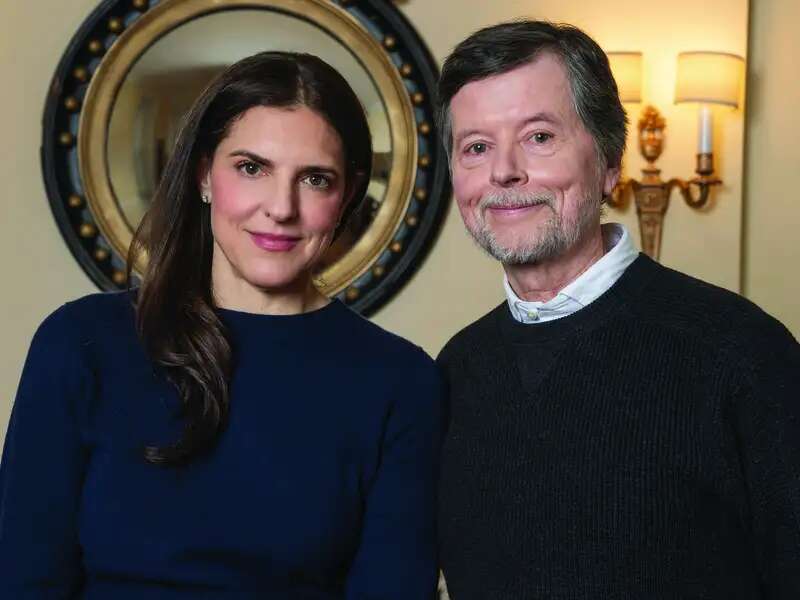
Ahead of Ken Burns’s Latest Docuseries, Co-Director Sarah Botstein '94 Shares her Path, Process.

A key part of the work that Shelby Semmes ’06 does as the New England vice president of Trust for Public Land — an organization dedicated to creating parks and protecting the outdoors — is to identify areas of privately held land that would benefit from public ownership or conservation status. So when an industrial timber company put 31,367 acres up for sale in the Katahdin region of Maine in late 2022, Semmes and her colleagues knew they had to act fast.
Situated near the base of Mount Katahdin, the forested land is home to 4,000 acres of wetlands and 53 miles of streams, as well as an aquatic and wildlife habitat that includes moose, bear, Canada lynx, salmon, and wood turtles. It also abuts the Katahdin Woods and Waters National Monument, a giant swath of acreage along the East Branch of the Penobscot River.
And significantly, the property is the ancestral land of the Penobscot Nation — an area sacred to the tribe’s community and culture.
“We bought it thinking about who was best fit to take it long term,” says Semmes.
In November 2023, Trust for Public Land announced a plan to “return nearly 30,000 acres of land taken from the Penobscot Nation in the 19th century,” representing the largest land return between a nonprofit and a tribal nation in the United States.
The organization comes to this project with years of experience restoring tribal and Indigenous lands across the U.S., from California to Hawaii.
“Part of the problem we’re working to address is that Indigenous people in the U.S. steward and maintain only 2% of their ancestral lands, and in Maine, that’s even lower,” says Semmes.
Studies have found that Indigenous-protected areas often function as well as, or even better than, those managed by government agencies or established conservation groups.
“We’re hoping to have a historically significant partnership to restore the land to not only Penobscot management but their natural resource expertise and knowledge,” Semmes says. As legal stewards of the land, the Penobscot Nation will be the decision-makers on all conservation and land-use matters, from overseeing the protection of wildlife to mitigating the effects of climate change.
When the land transfer is completed, Semmes says, “it will be a true highlight of my career that has sincere roots in my time at Barnard.”
Her interest in environmental conservation, however, started even before college, when she spent summers and long weekends visiting the White Mountain National Forest, where her family owned a homestead perched near the Sandwich Range. On the edge of the wilderness, Semmes would roam unsupervised in the woods for hours at a time — paddling in a pond, exploring brooks and wetlands, and discovering frogs.
“I don’t think I realized how unusual it was to have such a deep understanding and exposure and access to a national forest,” Semmes says.
But it wasn’t until her time at Barnard that her love for and connection to the outdoors blossomed into her life’s purpose. At Barnard, Semmes studied anthropology with a minor in economics. She took courses with anthropology professor Paige West, who was then focused on studying the flaws of fortress conservation, a model based on the idea that biodiversity is best protected through ecosystems that function in isolation, away from human disturbance.
It was West’s scholarship, Semmes says, that helped inspire her to pursue environmental work. “I wanted to think about natural resources and communities who benefit from them — not only recreationally but for their livelihoods.”
After pursuing a master’s in forestry from the Yale School of the Environment, Semmes got a job at Trust for Public Land, which, she says, takes a people-centric approach to land conservation. “The idea that lands are managed through participatory and, in many cases, public governance models felt very aligned with me in terms of the conservation work I wanted to be doing,” she says. “That stuck with me.”
After more than a decade of doing conservation work, Semmes has quite a few professional milestones under her belt. She has helped to protect the biggest patch of unconserved private land in the Green Mountain National Forest, established community forests for rural development through participatory management processes, and addressed the outdoor equity gap in Boston and other cities.
As part of the land transfer with the Penobscot Nation, Semmes and Trust for Public Land are currently working with tribe leaders to establish public roads to the Katahdin Woods and Waters National Monument to further enhance access for the Maine communities of Millinocket, East Millinocket, Medway, and others. “We hope that it will create a right of way or the road will become a part of the national monument to allow visitors access,” explains Semmes.
They also hope to ensure trail connections, which bring an economic boost to surrounding communities through associated tourism. But there is still a long road ahead. Trust for Public Land and the Penobscot Nation are currently fundraising in an effort to reach their goal of $32 million to transfer the property to the Nation.
“We’re $6 million into this, and we’re looking at the role of private philanthropy and public grants,” Semmes says.
Likewise, the vision to make roadways available will rely on enactment of new federal legislation to authorize the National Park Service to acquire property interests on the roads and associated lands.
The challenges for conservationists like Semmes are great. By the end of 2060, New England states are projected to lose 1.2 million acres of forested land and 17% of their carbon storage capacity — partly as a result of low-cost subdivision and land development.
For Semmes, however, the uphill battle only solidifies her belief that her work is more important than ever.
“Investments in land conservation are part of how a life well lived is accomplished,” she says. “By having people embrace and experience that reality, we’ll have a better chance.”